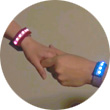|
Research

Cybernics / Augmented Human / Biomedical Engineering
Wearable robots, Assistive / Rehabilitation robotics, Biorobotics, Biosignal processing
|
Cybernics is a new domain of interdisciplinary academic field of human-assistive technology to enhance, strengthen, and support limited cognitive and physical capabilities. In order to create a future society where assisted lifestyles will become widely available, several researches are being conducted. In particular, we are interested in Augmented Human. Several wearable or modular devices are used in this study, which enable behavior and affective measurements based on augmented human technology.
The researches on cognitive robotics will also be tightly related to human-assistive robotics. The understanding of human cognitive process by building cognitive machines definitely contributes to enhance, strengthen, and support human'scognitive and physical functions.
 These researches are conducted at the Center for Cybernics Research. These researches are conducted at the Center for Cybernics Research.
|
|
|
| |
|
|

Social Interaction / Autism and Developmental Disorders Studies
Social Playware, Music Technology, Socio-Musical Interaction
|
We have been investigating Social Playware, which is regarded as cyber-physical systems to support and enhance the experiences on play and social interaction among people. It is realized by measuring and presenting physical and physiological chracteristics with wearable devices and modular devices. Regarding the measurement of affective information, we also have been investigating on music technology, such as virtual musical instruments and music/sound creation.
Regarding understanding social interaction among people, we have been investigating on music technology, such as virtual musical instruments and music/sound creation. We also are interested in a new type of HCI paradigm; inviting interface for human communication. 1-bit signal communication allows everybody, from children to elderly persons, to use these devices and feel a sense of "connected" with their friends and family at any time and place, even during work or working.
 This work is partially supported by JST. This work is partially supported by JST.
 Social Imaging is a technology to identify and represent social behaviors. One of our goals is to establish a developmental support system especially for autistic children. Social Imaging is a technology to identify and represent social behaviors. One of our goals is to establish a developmental support system especially for autistic children.
|
|
|
| |
|
|

Social Robotics / Cognitive Robotics
Humanoid robotics, Machine learning, Human-robot Interaction, biologically inspired robots
|
In the field of cognitive robotics both internal/central process and representations are investigated in order to build a future robot which performs with autonomy in real and dynamic world. The cognitive robots are able to learn from its experience and update the knowledge and internal representation. In addition to autonomous robot, robotics with humans in the loop play an important and significant roles: assistive robotics, social robotics, human robot interaction, and biologically inspired robots (human perception and action). These future robots will be tightly coupled with human society and seamlessly integrated in human environments.
We try to understand the embodied intelligence by our robot: upper-torso, Human-size anthropomorphic humanoid robot, namely Genie. We consider that the key issue for future cognitive machines is reasoning and the form of representation. Central will be an understanding of embodied intelligence.
|
|
|
| |
|
|

Emerging Technologies
Evolutionary robotics, Mixed Reality, Teleoperation, Mobile robotics, Face studies
|
Several researches in different domains are conducted, in particular, Evolutionary robotics / computation, Machine initiative & awareness, etc, from theoretical works to practical applications in the future. Also, a modeling taking insights from the human subjectivity and individual preference is an important issue. This includes the terms of individual emotional resonance, comfort and satisfaction.
In order for a robot to realize self-sustain, the autonomous functions that execute the energy strategy algorithm based on self-preservation is required. Focusing on the survival ability of machines, in which we have been creating an autonomous survival robot with regard to energy. We also focus on subjective effects regarding the robot vision system such as attention and illusion (i.e. "trick of the eye") One approach is biased image processing. This is a challenging topic related to subjective computing.
|
|
|

|



